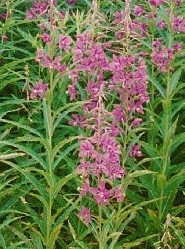 This perennial wildflower is a native of North America as well as Eurasia where it is found in disturbed sites such as meadows and roadsides, and is especially common after fire. A member of the Evening Primrose family (Onagraceae) it was formerly known as Epilobium angustifolium. Tall, erect, reddish stems bear long narrow willow-like leaves up to ten inches in length. The veins of the leaves are circular and join inside the leaf margins rather than at the edge, a unique characteristic that makes the plant easy to identify even when young. Stems are topped by a spike of fifty or more pink, magenta or, occasionally white, flowers in summer. The flowers have four petals and open gradually toward the top of the spike. Each flower is short-lived and is attractive to bees, moths, and hummingbirds. Reddish brown seed capsules are about three inches long and contain 300-400 seeds each with a tuft of silky hairs at one end that facilitate wind seed dispersal. Once the plant is established it spreads by its rhizomatous root system and can quickly fill a large area. Its relatively aggressive growth can be a problem in the garden. The genus name, Chamerion, comes from the Greek words chamai meaning dwarf and nerion meaning oleander and refers to the resemblance of plant leaves to those of oleander. The specific epithet, angustifolium, comes from the Latin words angustus meaning narrow and folium meaning leaf and refers to the appearance of the leaves.
This perennial wildflower is a native of North America as well as Eurasia where it is found in disturbed sites such as meadows and roadsides, and is especially common after fire. A member of the Evening Primrose family (Onagraceae) it was formerly known as Epilobium angustifolium. Tall, erect, reddish stems bear long narrow willow-like leaves up to ten inches in length. The veins of the leaves are circular and join inside the leaf margins rather than at the edge, a unique characteristic that makes the plant easy to identify even when young. Stems are topped by a spike of fifty or more pink, magenta or, occasionally white, flowers in summer. The flowers have four petals and open gradually toward the top of the spike. Each flower is short-lived and is attractive to bees, moths, and hummingbirds. Reddish brown seed capsules are about three inches long and contain 300-400 seeds each with a tuft of silky hairs at one end that facilitate wind seed dispersal. Once the plant is established it spreads by its rhizomatous root system and can quickly fill a large area. Its relatively aggressive growth can be a problem in the garden. The genus name, Chamerion, comes from the Greek words chamai meaning dwarf and nerion meaning oleander and refers to the resemblance of plant leaves to those of oleander. The specific epithet, angustifolium, comes from the Latin words angustus meaning narrow and folium meaning leaf and refers to the appearance of the leaves.
Type: Herbaceous perennial
Bloom: Spikes of pink to magenta (occasionally white) four petaled flowers in summer
Size: 2-5′ H x 1.5-3′ W
Light: Full sun; tolerates some shade but declines
Soil: Mineral, dry to moist, well-drained; tolerates acidic soil
Care: Contain spread if necessary
Hardiness: Zones 3-8
Pests and Diseases: None of significance
Propagation: Seed, division
Companion Plants: Especially effective in large stands agains a backdrop of greenery.
